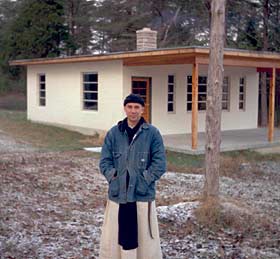 Stephanie Simon of The Los Angeles Times scored a coup: She interviewed young evangelicals who left their previous lives to live as monastics. Her story was rich with detail and nuance. But I wonder if she missed a major story.
Simon introduced readers to five young adults, plus their children, who left their comfortable suburban homes for a spartan, communal one. As you may imagine, Simon described in great detail the travails and triumphs of such a radical life change. Here is how she depicted the decision by one of the families, the Porrett's, to leave the house:
Stephanie Simon of The Los Angeles Times scored a coup: She interviewed young evangelicals who left their previous lives to live as monastics. Her story was rich with detail and nuance. But I wonder if she missed a major story.
Simon introduced readers to five young adults, plus their children, who left their comfortable suburban homes for a spartan, communal one. As you may imagine, Simon described in great detail the travails and triumphs of such a radical life change. Here is how she depicted the decision by one of the families, the Porrett's, to leave the house:
"I'm never alone. I never have time to think," [Phyllis Porrett] said. "There's no time to grow."
Communal life was supposed to have taught her to resolve conflicts. Instead, Phyllis said, she found herself obsessing about every grievance: how many nights in a row she made dinner, or who had scratched her coffee table.
Far from learning to live like Christ, she'd realized just how far she was from that ideal. "I'm not a very gracious person," Phyllis said. "I don't love people the way God does."
In August, she and Kyle announced that they could not keep their yearlong commitment to the house. They had learned they could adopt their foster children, and they wanted to start fresh in their own home that fall.
Yet why did these five adults decide to form a religious community? To my mind, Simon's answer is inadequate:
The couples came to monasticism out of frustration, a sense that modern Christianity had grown soft and self-centered.
Jeromy, 29, and Debbie, 30, worshiped at an evangelical church with a bouncy six-piece band, but they thought the sermons empty; they went more out of habit than conviction. Kyle, 30, and Phyllis, 25, had stopped going to church because their lives were too hectic.
The two couples and Jake, 29, sought a more fulfilling path in the Bible. They found themselves drawn to accounts of how Peter organized the early church into communities of believers. Members sold all they owned, shared necessities in common, and "continuing daily with one accord . . . did eat their meat with gladness and singleness of heart."
In other words, the couples were dissatisfied with their religion and sought to imitate the early Christians. Maybe this is true, but it sounds like something's missing. Dissatisfaction with one's religion at some point is practically a universal sentiment. Few believers, however, abandon their former lives to live like monks.
Simon mentions earlier in the story that the couples are part of "the New Monastic movement sweeping white, suburban evangelicals." But she makes it sound like a fad rather than a revolutionary social movement. Indeed, the movement describes itself in radical terms:
Throughout the history of the church, monastic movements have arisen during times of rapid social change. When the minority movement that Jesus started was flooded by converts after Constantine, desert mothers and fathers went into their cells to discern a new way of life. When Europe collapsed into the Dark Ages, Benedictines carved out spaces for community and new life. When the advent of a cash economy revolutionized European culture, St. Francis started an order of beggars to proclaim the divine economy of providence. Over the past two thousand years, monasticism has helped the church remember who we are.
Ours is a time of rapid social change. We are post-modern, post-Cold War, post-9/11, even post-Christian. All signs point to change, and we know things aren't what they used to be. But we hardly know who we are. Amidst wars and rumors of war, our global identity crisis threatens to consume us.
This description casts the adults' decision to form a religious community in a wholly new light. These people are more than a bunch of well-meaning Christians. They are spiritual revolutionaries, ones who seek to create alternative communities in our age of globalization. They seek mysticism and community, not materialism and individualism; prayer and alms, not money and fame; the way of Thomas Merton and Mother Teresa, not that of Creflo Dollar and Joyce Meyer.
Now perhaps the young evangelicals depicted in this story don't see their lives in those terms. But at the least, Simon should have probed their motives more.
